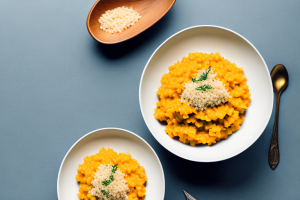How to steam basmati rice with cardamom and cinnamon
7 min read
A pot of steaming basmati rice with cardamom and cinnamon
If you’re tired of plain old rice, you may be looking for ways to give it some flavorful pizazz. Steaming basmati rice with cardamom and cinnamon is a great way to achieve that goal. In this article, we’ll guide you through the process of steaming basmati rice with these aromatic spices, from choosing the right equipment to serving suggestions. By the end, you’ll be a basmati rice steaming pro!
Why basmati rice is the perfect choice for steaming with cardamom and cinnamon
Basmati rice is a long-grain rice that originates from India and Pakistan. It has a distinct nutty aroma and flavor, and its long, slender grains become fluffy and separate when cooked properly. Basmati rice is the perfect choice for steaming with cardamom and cinnamon because its delicate flavor profile complements these spices perfectly. The fragrant aroma of basmati rice pairs perfectly with the warm, sweet flavors of cardamom and cinnamon. Together, they create a delicious, aromatic dish that’s perfect for any occasion.
In addition to its delicious taste and aroma, basmati rice is also a healthier option compared to other types of rice. It has a lower glycemic index, which means it doesn’t cause a rapid spike in blood sugar levels. Basmati rice is also rich in fiber, vitamins, and minerals, making it a nutritious addition to any meal. So not only does it taste great when steamed with cardamom and cinnamon, but it’s also a healthier choice for you and your family.
The health benefits of adding cardamom and cinnamon to your rice
Cardamom and cinnamon come with a host of health benefits. Cardamom is an excellent source of antioxidants and has been shown to help with digestive issues, such as bloating and constipation. It also has anti-inflammatory properties that can help ease pain and discomfort. Cinnamon is also high in antioxidants and has anti-inflammatory properties. It has been suggested that cinnamon can improve cognitive function and lower blood sugar levels.
When adding cardamom and cinnamon to your rice, you not only enhance the flavor but also boost the nutritional value of your meal. Cardamom and cinnamon are both rich in essential minerals such as calcium, iron, and magnesium. These minerals are crucial for maintaining healthy bones, muscles, and nerves. Additionally, cardamom and cinnamon have been found to have antimicrobial properties that can help fight off harmful bacteria and viruses in the body. So, next time you cook rice, consider adding a pinch of cardamom and cinnamon to reap their health benefits.
Choosing the right equipment for steaming rice
The first step in steaming rice is choosing the right equipment. You’ll need a pot with a tight-fitting lid and a steaming basket. The pot should be large enough to fit your steaming basket comfortably, and the lid should fit snugly to keep the steam from escaping. If you don’t have a steaming basket, you can use a colander or a mesh strainer instead.
It’s important to note that the material of the pot and steaming basket can also affect the quality of the steamed rice. Stainless steel and aluminum are popular choices for pots, while bamboo and metal are common materials for steaming baskets. Each material can impart a slightly different flavor and texture to the rice, so it’s worth experimenting to find your preferred combination.
Another factor to consider is the amount of water used in the steaming process. Generally, the ratio of water to rice is 2:1, but this can vary depending on the type of rice and personal preference. It’s important to measure the water accurately and avoid lifting the lid during the steaming process to prevent the steam from escaping and affecting the cooking time and texture of the rice.
Preparing your basmati rice for steaming
Before you start steaming your rice, you need to prepare it properly. Rinse the rice thoroughly in cold water until the water runs clear. This will remove any excess starch and dirt from the rice, ensuring that it cooks evenly. Soak the rice in cold water for at least 30 minutes before cooking. This will help the grains absorb water and cook more quickly.
The perfect ratio of water to rice for steaming
The ratio of water to rice for steaming is important. For basmati rice, the perfect ratio is 1.5 cups of water to 1 cup of rice. This will result in fluffy, tender rice that’s neither too dry nor too moist. Bring the water to a boil in your pot before adding the rice. Once you add the rice, reduce the heat to low, cover the pot, and let the rice cook for 15-20 minutes.
It’s important to note that the perfect ratio of water to rice may vary depending on the type of rice you’re using. For example, brown rice may require more water and a longer cooking time than white rice. It’s always a good idea to check the cooking instructions on the package or do some research to find the best ratio for the type of rice you’re cooking. Additionally, adding a pinch of salt to the water before adding the rice can enhance the flavor of the rice.
Adding spices to your rice before or after cooking – which is better?
When it comes to adding spices to your rice, you can do it either before or after cooking. If you add the spices before cooking, they will cook with the rice, infusing their flavors throughout. This can result in a deeper, richer flavor. If you add the spices after cooking, they will retain their individual flavors and aromas more fully. Ultimately, it comes down to personal preference.
However, there are some spices that are better added before cooking. For example, if you are using whole spices like cinnamon sticks or bay leaves, it is best to add them before cooking so that they have time to release their flavors. On the other hand, if you are using delicate spices like saffron or cardamom, it is better to add them after cooking to preserve their delicate flavors.
Another factor to consider is the type of rice you are using. If you are cooking long-grain rice like basmati, it is better to add the spices before cooking as the rice will absorb the flavors better. However, if you are cooking short-grain rice like sushi rice, it is better to add the spices after cooking as the rice is stickier and will retain the flavors better.
How to add cardamom and cinnamon to your rice for maximum flavor
To add cardamom and cinnamon to your rice, you’ll need to crush the cardamom pods and add both spices to the rice before cooking. For best results, toast the spices in a dry pan before crushing them. This will help release their fragrant oils and enhance their flavors. Alternatively, you can infuse the spices in hot water and add the resulting mixture to the rice while cooking. This will also give the rice a lovely aroma and flavor. Don’t be shy with the spices – use as much or as little as you prefer!
Cardamom and cinnamon are not only delicious, but they also have health benefits. Cardamom is known to aid digestion, fight bad breath, and even help with depression. Cinnamon, on the other hand, has anti-inflammatory properties and can help regulate blood sugar levels. So, adding these spices to your rice not only enhances the flavor but also provides some health benefits.
If you’re feeling adventurous, you can also add other spices to your rice, such as turmeric, cumin, or coriander. These spices can add a unique flavor and color to your rice. Just be sure to balance the flavors and not overpower the dish with too many spices.
Tips and tricks for perfectly cooked, fluffy basmati rice every time
There are a few tips and tricks that can help ensure that your basmati rice turns out perfectly every time. Make sure to use a tight-fitting lid and don’t open it during the cooking process. This will trap the steam inside the pot and help the rice cook evenly. Use a fork to fluff the rice after cooking – don’t use a spoon, as this can break up the grains and make them mushy. Lastly, keep a close eye on the rice while it’s cooking to ensure that it doesn’t burn or overcook.
Another important factor to consider when cooking basmati rice is the ratio of water to rice. Generally, you should use a ratio of 1.5 cups of water for every 1 cup of rice. However, this can vary depending on the age and quality of the rice, as well as your personal preference for the texture of the cooked rice.
If you want to add some extra flavor to your basmati rice, try adding some spices or herbs to the cooking water. Cumin, coriander, and cardamom are all great options that pair well with basmati rice. You can also add some chopped onions or garlic to the pot for a savory twist.
Serving suggestions and pairing ideas to elevate your dish
There are many ways to serve and pair steamed basmati rice with cardamom and cinnamon. One simple and delicious option is to add some raisins and slivered almonds to the rice just before serving. This will elevate the flavor and add some crunchy texture. You could also serve the rice as a side dish to a spiced chicken or lamb dish. The fragrant flavors of the rice will complement the rich, savory flavors of the meat perfectly!
Now that you know how to steam basmati rice with cardamom and cinnamon, it’s time to get cooking! Follow these tips and tricks, and you’ll be enjoying a delicious, flavorful bowl of rice in no time.
If you’re looking for a vegetarian option, try serving the rice with a creamy vegetable curry. The sweetness of the raisins and the nuttiness of the almonds will balance out the spiciness of the curry, creating a well-rounded and satisfying meal. Another option is to use the rice as a base for a flavorful grain bowl. Top it with roasted vegetables, a protein of your choice, and a drizzle of tahini sauce for a healthy and delicious meal.


